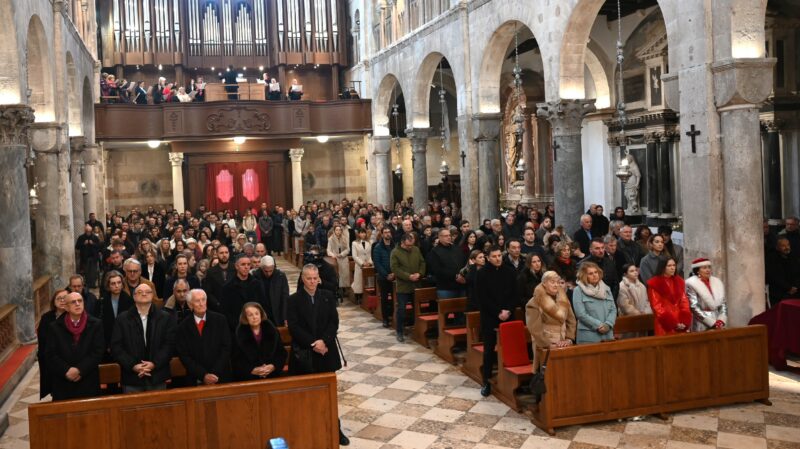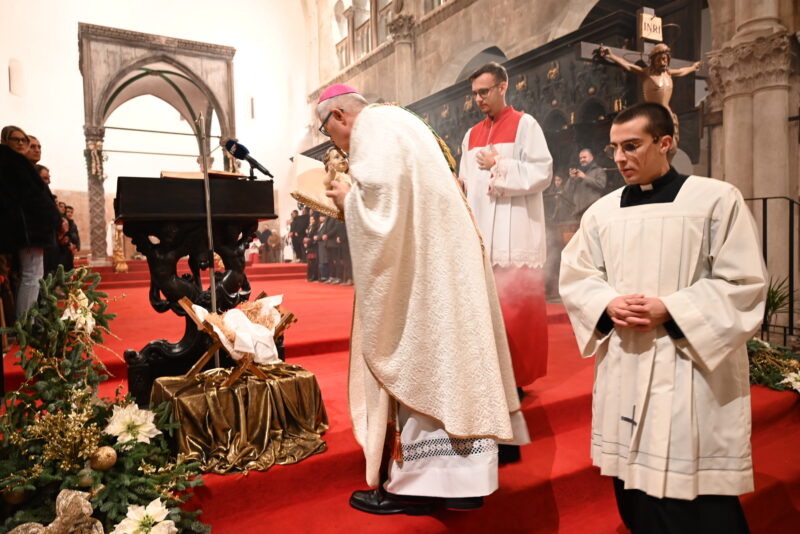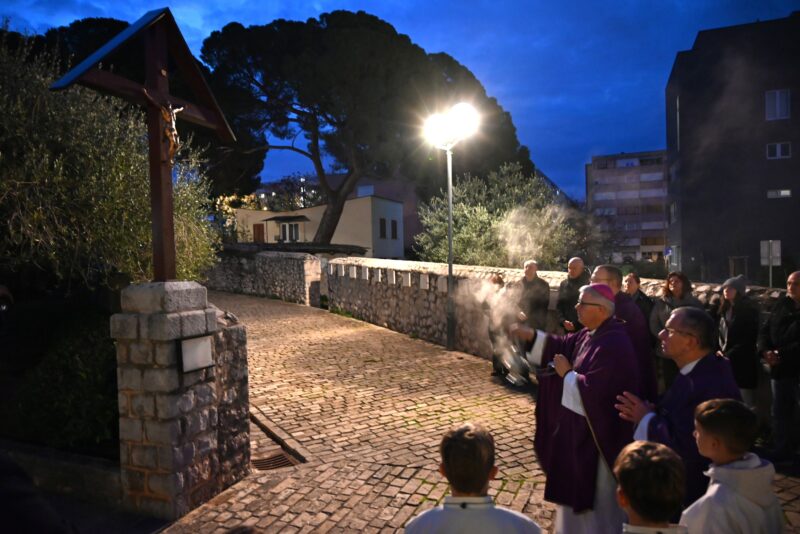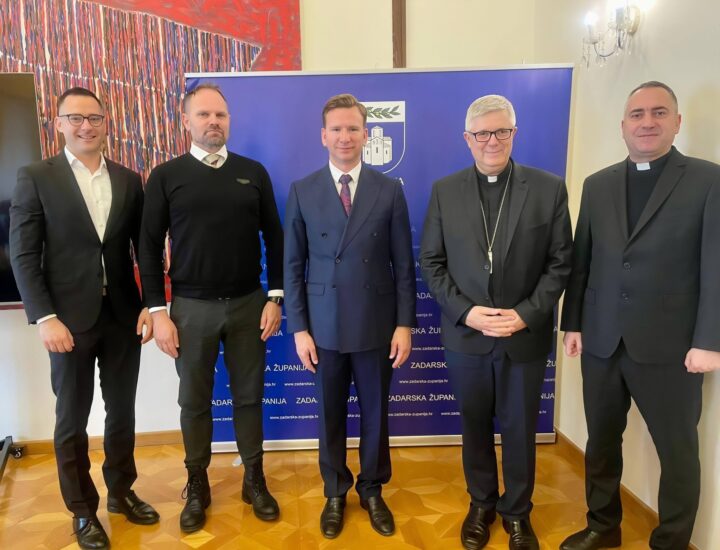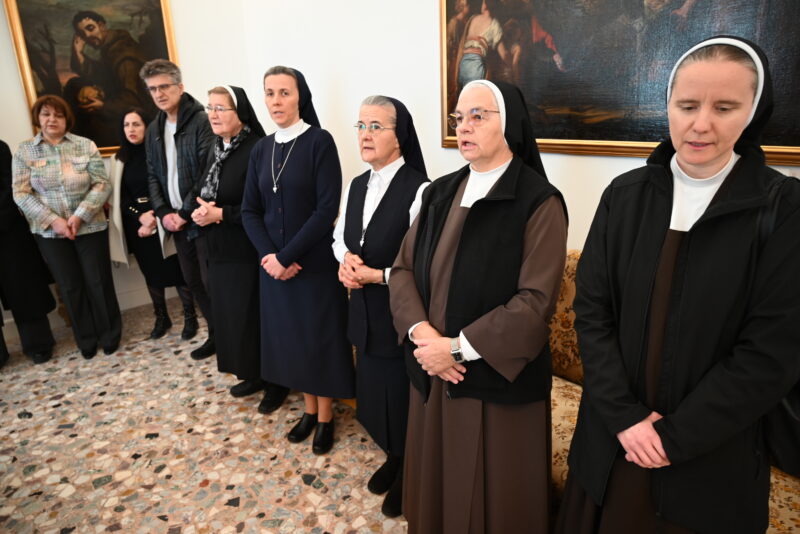Sakristija
Izaberi jezik | Choose a language
- HRVATSKI
- ENGLISH
- DEUTSCH
- ITALIANO
- FRANÇAIS
- PORTUGUÊS
- РУССКИЙ
- MAGYAR
- POLSKI
- ESPAÑOL
Sakristija
Sakristija ili kako se nekad nazivala kapela sv. Barbare sa svojim zidovima i apsidom kao i podnim mozaikom, pripada najstarijim dijelovima katedrale (prva polovica 5. stoljeća). U ranokršćanstvu ovaj prostor nazivao se katekumeneion, katekhoumeneion, mjesto za poduku vjere, a bio je smješten na prostoru triju bivših taberni na rimskome forumu.
Vrijedna ostavština ranokršćanstva jest i vrlo očuvan mozaik Izvor života (43,22 m2). Prikaz je to poznate biblijske teme iz starozavjetno psalma Jadikovke prognanog levita („Kao što košuta žudi za izvor-vodom, tako duša moja čezne, Bože, za tobom“, Ps 42, 2). Ukrašen akantusovim listovima, u središtu ima oveći vrč, kantharos, s košutom na lijevoj i jelenom na desnoj strani, što su tipični ranokršćanski motivi. Po geometrijskim motivima, vanjskom i unutarnjem okviru može se zaključiti da je ovaj mozaik nastao u 5. stoljeću u ravensko-akvilejskom kulturnom krugu. Pletenicu npr. pronalazimo u Akvileji, Poreču i u brojim drugim mjestima kasnoantičkog svijeta, a četiri u križ postavljena akantova lista pronalazimo i u Ravenni, Iesole, Gradu, Poreču…
U ranom srednjem vijeku, iz kasnoantičkog katekumeneiona, nastaje sakristija. U razdoblju gotike sakristija dobiva križasto-rebrasti svod i freske na zidovima. U dobrom stanju ostala je sačuvana freska „Jišajevo stablo“, koja prikazuje Isusovo rodoslovlje počevši od Jišaja, oca kralja Davida. Osim Jišaja, sačuvani su još neki likovi, kao npr. kralj David na tronu u sredini i četiri proroka sa strane. Najupadljiviji je lik samoga Jišaja, kojega je slikar pokušao postaviti kako u prirodnom položaju spava oslonjen na lakat lijeve ruke. Prema uobičajenoj ikonografiji Jišaj je prikazan kako spava. Ovdje je protivno ikonografiji prikazan gol s prekrivenim stidnim dijelom tijela, poput Krista. Iz srca mu se izvija zeleno stablo što podsjeća na usnulog Adama iz čijega je boka izašla Eva. Prikaz Jišajevog stabla u povijesti umjetnosti pojavljuje se od 11. do 15. stoljeća u ikonografiji, manuskriptima i na vitrajima od kojih je najpoznatiji onaj u katedrali u Chartresu.
Sacristy
Sacristy, or as it was once called the chapel of St. Barbara, with her walls and apse as well as floor mosaics, belongs to the oldest part of the cathedral (first half of the 5th century). In early Christianity, this space was called katekhoumeneion, a place of religious instruction, and was located on the site of three former roman type of shop or stall (taberna) in the Roman forum.
A valuable legacy of early Christianity is also the very valuable mosaic The Source of Life (43.22 m2). It is an illustration of a well-known biblical theme from the Old Testament, Psalm 42 (“As the deer pants for streams of water, so my soul pants for you, my God”). Decorated with acanthus leaves, in the centre is a pitcher, kantharos, with a hind on the left and a deer on the right, which are typical early Christian motifs. Based on the geometric motifs, the outer and inner frame, it can be concluded that this mosaic was created in the 5th century in the Ravenna-Aquileia cultural circle. For example, braid is found in Aquileia, Poreč and in many other places of the late antique world, and four acanthus leaves arranged in a cross are also found in Ravenna, Iesole, Grado, Poreč…
In the early Middle Ages, the sacristy was carved out of the Late Antique katekhoumeneion. In the Gothic period the sacristy was provided with a ribbed cross vault and frescoes on the walls. The “Tree of Jesse” fresco, depicting the genealogy of Jesus beginning with Jesse, father of King David, has been preserved in good condition.
In addition to Jesse, some other figures have been preserved, such as King David on the throne in the middle and four prophets on the sides. The most striking figure is the figure of Jesse himself, whom the painter tried to portray sleeping in a natural position, resting on the elbow of his left hand. According to the usual iconography, Jesse is shown sleeping. Here, contrary to iconography, the naked body is shown with the public part of the body covered, like Christ. A green tree twists from his heart, reminiscent of the sleeping Adam from whose side Eve emerged.
The depiction of Jesse’s tree in the history of art appears from the 11th to the 15th century in iconography, manuscripts, and stained-glass windows, the most famous of which is the one in Chartres Cathedral.
Die Sakristei
Die Sakristei, bzw. die Kapelle der hl. Barbara aus der erstem Hälfte des 5. Jh., gehört mit ihren Wänden, der Apsis und den Bodenmosaiken zum ältesten Teil der Kathedrale. Im frühen Christentum wurde dieser Raum katekhoumeneion (Ort der Glaubensunterweisung) genannt und befindet sich an der Stelle dreier ehemaliger Geschäfte oder Stände (taberna) auf dem römischen Forum.
Ein wertvolles Erbe des frühen Christentums ist auch das gut erhaltene Bodenmosaik mit dem Titel „Quelle des Lebens“ und einer Ausdehnung von 43,22 m2. Es ist die Darstellung eines bekannten biblischen Themas aus dem Alten Testament (Ps. 42): Wie der Hirsch lechzt nach frischem Wasser, so lechzt meine Seele, Gott, nach dir. In der Mitte befinden sich typisch frühchristliche Motive: ein mit Akanthusblättern verzierter Krug (kantharos) mit einer Hirschkuh auf der linken und einem Hirsch auf der rechten Seite. Aus den geometrischen Motiven, dem äußeren und inneren Rahmen lässt sich schließen, dass das Mosaik im 5. Jh. im Kulturkreis von Ravenna-Aquileia entstanden ist. Ein solches Geflecht findet sich z.B. in Aquileia, in Poreč und an vielen anderen Orten der spätantiken Welt. Die vier kreuzförmig angeordneten Akanthusblätter sind auch in Ravenna, Iesole, Grado, Poreč u.a. anzutreffen.
Im Frühmittelalter wurde die Sakristei aus dem spätantiken Katechumenenion herausgearbeitet. In der Gotik wurde sie dann mit einem Kreuzrippengewölbe und Fresken an den Wänden ausgestattet. In gutem Zustand erhalten ist das Fresko „Baum des Jesse“, das den Stammbaum Jesu, beginnend mit Jesse, dem Vater des Königs David, darstellt. Neben Jesse sind noch einige andere Figuren erhalten, wie König David auf dem Thron in der Mitte und vier Propheten an den Seiten. Am auffälligsten ist die Figur des Jesse selbst, den der Maler versuchte, in natürlicher Haltung schlafend und gestützt auf seinen linken Ellenbogen darzustellen. Die schlafende Darstellung des Jesse entsprach den Gewohnheiten der Ikonographie. Unüblich ist hier die Darstellung des nackten Körpers, dessen Schamteile nach dem Vorbild Christi bedeckt sind. Aus seinem Herzen windet sich ein grüner Baum, was an den schlafenden Adam erinnert, aus dessen Seite Eva hervorging. Die Darstellung des Jessebaumes findet sich in der Kunstgeschichte vom 11. bis zum 15. Jahrhundert sowohl in der Ikonographie als auch in Handschriften und auf Glasfenstern, deren berühmtestes sich in der Kathedrale von Chartres befindet.
Sacrestia
La Sacrestia, o come veniva chiamata un tempo la cappella di Santa Barbara, con le sue pareti e l’abside e i mosaici del pavimento, appartiene alla parte più antica della cattedrale (prima metà del V secolo). Nel primo cristianesimo, questo spazio era chiamato katekhoumeneion, un luogo di istruzione religiosa, e si trovava sul sito di tre antiche botteghe o bancarelle romane (taberna) nel foro romano.
Un prezioso lascito del primo cristianesimo è anche il preziosissimo mosaico La fonte della vita (43,22 m2). È un’illustrazione di un noto tema biblico dell’Antico Testamento, il Salmo 42 (“Come la cerva anela ai corsi d’acqua, così l’anima mia anela a te, o Dio”). Decorata con foglie d’acanto, al centro si trova una brocca, kantharos, con una cerva a sinistra e un cervo a destra, tipici motivi paleocristiani. In base ai motivi geometrici, alla cornice esterna e interna, si può concludere che questo mosaico è stato realizzato nel V secolo nella cerchia culturale di Ravenna-Aquileia. La treccia, ad esempio, si trova ad Aquileia, a Parenzo e in molti altri luoghi del mondo tardoantico, e le quattro foglie d’acanto disposte a croce si trovano anche a Ravenna, Iesole, Grado, Parenzo…
Nell’Alto Medioevo la sacrestia era ricavata dal katekhoumeneion tardoantico. Nel periodo gotico la sacrestia fu dotata di una volta a crociera costolonata e di affreschi alle pareti. L’affresco “L’albero di Jesse”, che raffigura la genealogia di Gesù a partire da Jesse, padre del re Davide, si è conservato in buone condizioni.
Oltre a Jesse, si sono conservate altre figure, come il re Davide in trono al centro e quattro profeti ai lati. La figura più sorprendente è quella di Jesse stesso, che il pittore ha cercato di ritrarre mentre dorme in posizione naturale, appoggiato sul gomito della mano sinistra. Secondo l’iconografia abituale, Jesse è raffigurato mentre dorme. Qui, contrariamente all’iconografia, il corpo nudo è rappresentato con la parte pubblica del corpo coperta, che allude al corpo di Cristo. Dal suo cuore si diparte un albero verde, che ricorda l’Adamo addormentato dal cui fianco emerse Eva.
La rappresentazione dell’albero di Jesse nella storia dell’arte compare dall’XI al XV secolo nell’iconografia, nei manoscritti e nelle vetrate, la più famosa delle quali è quella della Cattedrale di Chartres.
Sacristie
La sacristie, ou, comme on l’appelait autrefois, la chapelle Sainte-Barbe, avec ses murs et son abside ainsi que ses mosaïques au sol, appartient à la partie la plus ancienne de la cathédrale (première moitié du Ve siècle). Au début du christianisme, cet espace était appelé katekhoumeneion, un lieu d’instruction religieuse, et était situé à l’emplacement de trois anciennes boutiques ou échoppes romaines (taberna) dans le forum romain.
La très précieuse mosaïque La source de la vie (43,22 m2) est également un héritage précieux du christianisme primitif. Elle illustre un thème biblique bien connu de l’Ancien Testament, le Psaume 42 (« Comme le cerf languit après les ruisseaux d’eau, ainsi mon âme languit après toi, mon Dieu »). Décorée de feuilles d’acanthe, elle présente au centre une cruche, kantharos, avec une biche à gauche et un cerf à droite, motifs typiques du christianisme primitif. Les motifs géométriques, le cadre extérieur et intérieur permettent de conclure que cette mosaïque a été créée au Ve siècle dans le cercle culturel Ravenne-Aquilée. Par exemple, la tresse se retrouve à Aquilée, à Poreč et dans de nombreux autres endroits du monde antique tardif, et quatre feuilles d’acanthe disposées en croix se retrouvent également à Ravenne, Iesole, Grado, Poreč…
Au début du Moyen Âge, la sacristie était creusée dans le katekhoumeneion de l’Antiquité tardive. À l’époque gothique, la sacristie a été dotée d’une voûte d’arêtes et de fresques sur les murs. La fresque de « l’arbre de Jessé », qui représente la généalogie de Jésus à partir de Jessé, père du roi David, a été conservée en bon état.
Outre Jessé, d’autres figures ont été conservées, comme le roi David sur le trône au centre et quatre prophètes sur les côtés. La figure la plus frappante est celle de Jessé lui-même, que le peintre a tenté de représenter endormi dans une position naturelle, reposant sur le coude de sa main gauche. Selon l’iconographie habituelle, Isaï est représenté endormi. Ici, contrairement à l’iconographie, le corps nu est représenté avec la partie publique du corps couverte, comme le Christ. Un arbre vert s’enroule autour de son cœur, rappelant l’Adam endormi du côté duquel Ève a émergé.
La représentation de l’arbre de Jessé dans l’histoire de l’art apparaît du XIe au XVe siècle dans l’iconographie, les manuscrits et les vitraux, dont le plus célèbre est celui de la cathédrale de Chartres.
Sacristia
A sacristia, ou como era chamada a capela de Santa Bárbara, com as suas paredes e abside, bem como os mosaicos do chão, pertence à parte mais antiga da catedral (primeira metade do século V). No início do cristianismo, este espaço era designado por katekhoumeneion, um local de instrução religiosa, e situava-se no local de três antigas lojas ou bancas romanas (taberna) no fórum romano.
Um valioso legado do cristianismo primitivo é também o valioso mosaico A Fonte da Vida (43,22 m2). Trata-se de uma ilustração de um conhecido tema bíblico do Antigo Testamento, o Salmo 42 (“Como o cervo anseia pelas correntes de água, assim a minha alma anseia por ti, meu Deus”). Decorado com folhas de acanto, tem no centro um jarro, kantharos, com uma corça à esquerda e um veado à direita, motivos típicos dos primeiros cristãos. Com base nos motivos geométricos, na moldura exterior e interior, pode concluir-se que este mosaico foi realizado no século V no círculo cultural Ravenna-Aquileia. Por exemplo, a trança é encontrada em Aquileia, Poreč e em muitos outros lugares do mundo antigo tardio, e quatro folhas de acanto dispostas em cruz também são encontradas em Ravenna, Iesole, Grado, Poreč …
No início da Idade Média, a sacristia foi esculpida no katekhoumeneion da Antiguidade Tardia. No período gótico, a sacristia foi dotada de uma abóbada de cruzaria nervurada e de frescos nas paredes. O fresco “Árvore de Jessé”, que representa a genealogia de Jesus a partir de Jessé, pai do rei David, foi conservado em bom estado.
Para além de Jessé, foram conservadas algumas outras figuras, como o rei David no trono, no centro, e quatro profetas nos lados. A figura mais marcante é a do próprio Jessé, que o pintor tentou representar a dormir numa posição natural, apoiado no cotovelo da mão esquerda. De acordo com a iconografia habitual, Jessé é representado a dormir. Aqui, contrariamente à iconografia, o corpo nu é representado com a parte pública do corpo coberta, como Cristo. Do seu coração sai uma árvore verde que lembra o Adão adormecido de cujo lado saiu Eva.
A representação da árvore de Jessé na história da arte aparece do século XI ao século XV na iconografia, nos manuscritos e nos vitrais, sendo o mais famoso o da catedral de Chartres.
Сакристия
Сакристия, или, как ее когда-то называли, часовня Святой Варвары, с ее стенами и апсидой, а также напольными мозаиками, относится к самой старой части собора (первая половина V века). В раннем христианстве это помещение называлось katekhoumeneion, место религиозного обучения, и располагалось на месте трех бывших римских магазинов или ларьков (taberna) на римском форуме.
Ценным наследием раннего христианства является также очень ценная мозаика «Источник жизни» (43,22 м2). Это иллюстрация к известному библейскому сюжету из Ветхого Завета, Псалму 42 («Как лань стремится к потокам воды, так душа моя стремится к Тебе, Боже мой»). Украшенный листьями аканта, в центре изображен кувшин, кантарос, с оленем слева и оленем справа, которые являются типичными раннехристианскими мотивами. На основании геометрических мотивов, внешнего и внутреннего обрамления можно сделать вывод, что эта мозаика была создана в V веке в культурном круге Равенна-Акилея. Например, тесьма встречается в Аквилее, Порече и во многих других местах позднеантичного мира, а четыре акантовых листа, расположенных крестом, также встречаются в Равенне, Иесоле, Градо, Порече…
В раннем Средневековье ризница была вырезана из позднеантичного катехуменейона. В готический период ризница получила ребристый крестовый свод и фрески на стенах. Фреска «Древо Иессея», изображающая генеалогию Иисуса, начиная с Иессея, отца царя Давида, сохранилась в хорошем состоянии.
Помимо Иессея, сохранились и другие фигуры, например, царь Давид на троне в центре и четыре пророка по бокам. Самой яркой фигурой является фигура самого Иессея, которого художник попытался изобразить спящим в естественной позе, опираясь на локоть левой руки. Согласно обычной иконографии, Иессей изображен спящим. Здесь же, вопреки иконографии, изображено обнаженное тело с прикрытой открытой частью тела, как у Христа. Из его сердца прорастает зеленое дерево, напоминающее о спящем Адаме, из бока которого вышла Ева.
Изображение древа Иессея в истории искусства появляется с XI по XV век в иконописи, рукописях и витражах, самый известный из которых находится в Шартрском.
Sekrestye
A sekrestye, vagy ahogy egykor nevezték, a Szent Barbara-kápolna, falaival és apszisával, valamint padlómozaikjaival a székesegyház legrégebbi részéhez tartozik (az 5. század első fele). A korai kereszténységben ezt a teret katekhoumeneion-nak, a vallási oktatás helyének nevezték, és a római fórumon három egykori római típusú bolt (bódé) (taberna) helyén állt.
A korai kereszténység értékes hagyatéka Az élet forrása (43,22 m2) című mozaik is. Ez egy jól ismert bibliai témát illusztrál az Ószövetségből, a 42. zsoltárból („Amint a szarvas kívánkozik a forrás vizéhez, úgy kívánkozik lelkem tehozzád, Istenem.”). Az ábrázolás akantuszlevelekkel díszített, középen egy korsó (kantharosz), balra és jobbra egy-egy szarvas látható, amelyek tipikus korai keresztény motívumok. A geometrikus motívumok, a külső és belső keret alapján arra lehet következtetni, hogy ez a mozaik az 5. században, a Ravenna-Aquileia-i kultúrkörben készült. Ezt a típusú fonatot megtaláljuk Aquileiában, Parenzo-ban (ma Poreč) és a késő antik világ számos más helyén, a négy keresztbe rendezett akantuszlevelet pedig szintén Ravennában, Equilium-ban (ma Jesolo), Grado-ban, Parenzo-ban (ma Poreč) stb.
A korai középkorban a sekrestyét az ókori katekhoumeneion-ból faragták ki. A gótikában a sekrestyét keresztboltozattal és a falakon freskókkal látták el. A Jessze vesszeje c. freskó, amely Jézus családfáját ábrázolja, kezdve Jessze, Dávid király apjával, jó állapotban maradt fenn.
Jessze mellett néhány más alak is fennmaradt, mint például a középen trónoló Dávid király és négy próféta az oldalakon. A legszembetűnőbb alak maga Jessze alakja, akit a festő igyekezett természetes testhelyzetben, bal könyökére támaszkodva alvó módon ábrázolni, amint az az ikonográfiában róla megszokott volt. Itt azonban ezzel ellentétben a meztelen test egy részét Krisztushoz hasonló módon letakarva ábrázolják. Továbbá, szívéből zöld fa ered, emlékeztetve az alvó Ádámra, akinek oldalából Éva származik.
Jessze vesszejének ábrázolása a művészettörténetben a 11. századtól a 15. századig jelenik meg ikonográfiákban, kéziratokban és ólomüveg ablakokban, amelyek közül a leghíresebb a chartres-i katedrálisban található.
Zakrystia
Zakrystia, czyli pierwotnie, kaplica św. Barbary, z jej ścianami i absydą, a także mozaikami podłogowymi, należy do najstarszej części katedry (pierwsza połowa V wieku). We wczesnym chrześcijaństwie przestrzeń ta nazywana była katekhoumeneion, miejscem nauczania religii i znajdowała się w miejscu trzech dawnych rzymskich sklepów lub straganów (taberna) na rzymskim forum.
Cenną spuścizną wczesnego chrześcijaństwa jest również bardzo wartościowa mozaika „Źródło życia” (43,22 m2). Jest ona ilustracją znanego motywu biblijnego ze Starego Testamentu, Psalmu 42 (“Jak łania łaknie strumieni wody, tak dusza moja łaknie Ciebie, Boże mój“). Ozdobiona liśćmi akantu, w centrum znajduje się dzban, kantharos, z łaniom po lewej i łaniom po prawej stronie, które są typowymi motywami wczesnochrześcijańskimi. Na podstawie motywów geometrycznych, zewnętrznej i wewnętrznej ramy można stwierdzić, że mozaika ta została stworzona w V wieku w kręgu kulturowym Rawenna-Akwileja. Na przykład warkocz występuje w Akwilei, Poreč i w wielu innych miejscach świata późnego antyku, a cztery liście akantu ułożone w krzyż występują również w Rawennie, Iesole, Grado, Poreč…
We wczesnym średniowieczu, z późno antycznego katekhoumeneionu, powstaje dzisiejsza zakrystia. W okresie gotyku zakrystia została wyposażona w żebrowane sklepienie krzyżowe i freski na ścianach. Fresk “Drzewo Jessego“, przedstawiający genealogię Jezusa począwszy od Jessego, ojca króla Dawida, zachował się w dobrym stanie.
Oprócz Jessego zachowało się kilka innych postaci, takich jak król Dawid, pośrodku na tronie i czterech proroków po bokach. Najbardziej wyróżniającą postacią jest postać samego Jessego, którego malarz starał się przedstawić śpiącego w naturalnej pozycji, opierającego się na łokciu lewej ręki. Zgodnie z wymogami ikonografii, Jesse jest pokazany jako śpiący. Tutaj, jednak niezgodnie z ikonografią, nagie ciało jest pokazane z zakrytą intymną częścią, jak Chrystus. Z jego serca wyrasta zielone drzewo, przypominające śpiącego Adama, z którego boku wyłoniła się Ewa.
Przedstawienie drzewa Jessego w historii sztuki pojawia się od XI do XV wieku w ikonografii, manuskryptach i witrażach, z których najsłynniejszym jest ten w katedrze w Chartres.
Sacristía
La sacristía, o como se llamaba antes la capilla de Santa Bárbara, con sus muros y ábside, así como los mosaicos del suelo, pertenece a la parte más antigua de la catedral (primera mitad del siglo 5). En el cristianismo primitivo, este espacio se llamaba katekhoumeneion, un lugar de instrucción religiosa, y estaba situado en el emplazamiento de tres antiguas tiendas o puestos (taberna) de tipo romano en el foro romano.
Un valioso legado del cristianismo primitivo es también el valiosísimo mosaico La fuente de la vida (43,22 m2 ). Es una ilustración de un conocido tema bíblico del Antiguo Testamento, el Salmo 42 (“Como la cierva anhela las corrientes de agua, así mi alma te anhela a ti, Dios mío“). Decorada con hojas de acanto, en el centro hay un cántaro, kantharos, con una cierva a la izquierda y un ciervo a la derecha, motivos típicos paleocristianos. Basándose en los motivos geométricos, el marco exterior y el interior, se puede concluir que este mosaico fue creado en el siglo V en el círculo cultural Rávena-Aquilea. Por ejemplo, el trenzado se encuentra en Aquileia, Poreč y en muchos otros lugares del mundo tardoantiguo, y cuatro hojas de acanto dispuestas en cruz se encuentran también en Rávena, Iesole, Grado, Poreč…
A principios de la Edad Media, la sacristía se talló en el katekhoumeneion de la Antigüedad Tardía. En el periodo gótico, la sacristía se dotó de una bóveda de crucería y frescos en las paredes. El fresco del “Árbol de Jesé”, que representa la genealogía de Jesús empezando por Jesé, padre del rey David, se ha conservado en buen estado.
Además de Jesé, se conservan otras figuras, como el rey David, entronizado en el centro, y cuatro profetas a los lados. La figura más llamativa es la del propio Jesé, a quien el pintor trató de representar durmiendo en posición natural, apoyado en el codo de su mano izquierda. Según la iconografía habitual, Jesé es representado durmiendo. Aquí, contrariamente a la iconografía, el cuerpo desnudo se muestra con la parte pública del cuerpo cubierta, como Cristo. Un árbol verde se retuerce desde su corazón, recordando al Adán dormido de cuyo costado surgió Eva.
La representación del árbol de Jesé en la historia del arte aparece desde el siglo XI al XV en iconografía, manuscritos y vidrieras, la más famosa de las cuales es la de la catedral de Chartres.
Aktualnosti
Najava događanja
Nema nadolazećih najava

